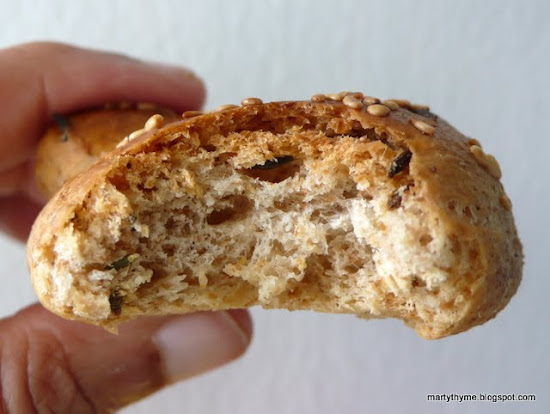 |
| IRAQI BREAD BRACELETS |
I was looking for a recipe for Italian taralli pugliese in one of my bread books when I came upon this recipe for kahk and noticed the similiarities between these two bread snacks. Both are looped into a ring or bracelet shape, contain olive oil and are seasoned with spices – cumin and coriander in kahk and fennel in taralli. The difference is the addition of white wine in taralli, and the rings are first poached like bagels before they are baked.

The recipe for kahk comes from Linda Collister's
Bread: From Ciabatta to Rye .
. She writes in her introduction to the recipe that kahk are Arab bread bracelets or rings and the one she presents in her book is an Iraqi recipe. I read that there is also a sweet variety, filled with dates and nuts, or plain dusted simply with sugar.
After reading some recipes for taralli online, I thought why not use Linda Collister's recipe for the kahk, which makes 18 bracelets, and divide that into kahk and taralli? I substituted the cumin and coriander with fennel, and omitted the wine (since I didn't have any). Because I had a little bit of discard from a
sourdough leaven I was going to use the next day, I added that to the mix.
After shaping into rings, I proceeded to bake half of them for kahk and poach the other half before baking for taralli.
This has to work, I thought, or I'll have people
from two countries laughing at me.
Well, as it turned out, I didn't quite pull off either one. My "mock" taralli failed completely. They were pallid and tasted raw despite being cooked twice (poached and baked). I had let the dough rise overnight in the fridge and poached them the next morning without allowing them to come to room temperature. Can that have been the reason for the insipid look and taste, I wonder.
The kahk are twice-baked, first in a medium hot oven, then at a lower temperature to crisp up. I didn't let the oven cool down significantly before the second baking, so they were hard and a little burnt. But when I managed to crack one with my teeth, it tasted better than it looked. If made well, I can see myself chewing on these crisps all day.
Which meant a second attempt was in order. This time, the kahk turned out good! They were crisp on the outside but tender on the inside. My jaw didn't hurt and my teeth were still intact. I am submitting this recipe to
YeastSpotting (which
discussed taralli pugliese some time ago).
I'm going to get those taralli to work next.
 |
| Perfect for dunking |
KAHK
From Bread: From Ciabatta to Rye by Linda Collister
Makes 18
300g unbleached strong bread flour
1 teaspoon sea salt
2 teaspoons cumin seeds, roasted*
1 teaspoon coriander seeds, roasted and ground*
1½ teaspoons (7g) instant dried yeast
100ml tepid water
100ml olive oil
1 egg, beaten, to glaze
Sesame seeds*, to sprinkle
- Put the flour, salt, roasted and ground seeds and yeast in a large bowl and mix well. Make a well in the centre.
- Add the water and olive oil. Gradually draw the flour into the liquids to make a firm, heavy dough. If the dough feels a little sticky, work in a little more flour, 1 tablespoon at a time; if there are dry crumbs in the bowl, work in a little more tepid water, 1 tablespoon at a time.
- Turn out the dough onto a lightly floured work surface and knead thoroughly for 10 minutes. Return the dough to the bowl, cover and leave to double in size, about 1½ hours.
- Turn out the risen dough onto a lightly floured work surface and punch down to deflate. Divide into 18 equal pieces about the size of a walnut. Using your hands, roll the pieces into sausages about 12cm long. Overlap the ends to form rings.
- Arrange slightly apart well-greased baking sheets, then very lightly brush with beaten egg, taking care not to glue the dough to the sheets. Sprinkle with sesame seeds^. Slip the sheets into large plastic bags, slightly inflate, seal, then let rise as before until doubled in size, about 30 minutes.
- Meanwhile, preheat the oven to 190°C.
- Uncover the rings and bake for 25 minutes until firm and golden. Remove from the oven, turn down the heat to the lowest setting˜, then, when the oven has cooled sufficiently, bake for a further 20 minutes until crisp and dry. Cool on a wire rack.
- Eat immediately or store in an airtight tin for up to 1 month.
* Instead of cumin and coriander, I used
2½ teaspoons of fennel seeds only, roasted and left whole. Besides sesame seeds, I used onion (nigella) seeds as a garnish.
^ To get the seeds to stick better, I pressed a finger into the seeds and then pressed them on each egg-washed ring.
˜ Each oven will be different. I actually turn my oven off, wait about 10 minutes, then return the kahk to the oven to crisp and dry from the residual heat.
PRINTABLE RECIPE





